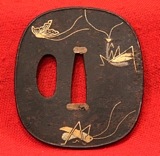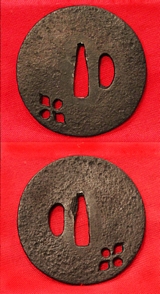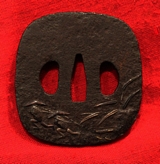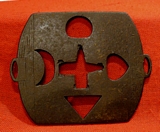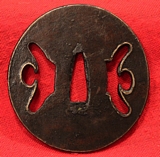Japanese
A Fine Edo Tsuba Kaga Kyoto Praying Mantis, Cricket Butterfly in Gold Inlay. From WW2 British RAF Commander & Hero Air Marshal Dowding's Collection
Circa 1730 from the family of Air Marshal Lord Dowding, commander of the Royal Airforce in WW2.
Iron plate inlaid with silver and gold superior Kaga Kyoto school tsuba of fine quality. After Hanabusa Itchō, a very popular subject in Japanese art in the late 17th to 18th century.
Tsuba were made by whole dynasties of craftsmen whose only craft was making tsuba. They were usually lavishly decorated. In addition to being collectors items, they were often used as heirlooms, passed from one generation to the next. Japanese families with samurai roots sometimes have their family crest (mon) crafted onto a tsuba. Tsuba can be found in a variety of metals and alloys, including iron, steel, brass, copper and shakudo. In a duel, two participants may lock their katana together at the point of the tsuba and push, trying to gain a better position from which to strike the other down. This is known as tsubazeriai pushing tsuba against each other.
2.5 inches x 2.25 inches read more
975.00 GBP
A Beautiful & Impressive Shinto Period Long Samurai Tanto Circa 1650
In all original Edo period fittings, including a pair of dragon menuki underneath original Edo two colour striped tsuka-ito, a flying goose in iron Higo fuchi complimented with a carved buffalo horn kashira, a super tsuba in iron with a takebori dragon around half of the edge to match the menuki. Original Edo lacquer saya in black ishime [stone finish] inset with an original Edo Kogatana utility knife, of a fine Oni demon tokebori kozuka on a nakago ground of patinated copper, the demon has a pure gold decorated sash onlaid. The habaki [blade collar] is finely and deeply chiselled at the botom half with a plain contrasting top half. The hira-zukuri blade is beautifully polished with a very clear and well defined deep notare hamon. The whole tanto is very attractive indeed, and all of the fittings, wrap tsuka and saya have been likely completely untouched or restored in around 150 years. The tanto is commonly referred to as a samurai's knife or dagger. The blade can be single or double edged [this one is single edged] with a length between 15 and 30 cm (6-12 inches, in Japanese 1 shaku). The tanto was designed primarily as a stabbing weapon, but the edge can be used for slashing as well. Tanto are generally forged in hira-zukuri style (without ridgeline), meaning that their sides have no ridge line and are nearly flat, unlike the shinogi-zukuri structure of a katana. Some tanto have particularly thick cross-sections for armour-piercing duty, and are called yoroi toshi. The tanto was invented partway through the Heian period. With the beginning of the Kamakura period, tanto were forged to be more aesthetically pleasing, and hira and uchi-sori tanto becoming the most popular styles. Near the middle of the Kamakura period, more tanto artisans were seen, increasing the abundance of the weapon, and the kanmuri-otoshi style became prevalent in the cities of Kyoto and Yamato. Because of the style introduced by the tachi in the late Kamakura period, tanto began to be forged longer and wider. The introduction of the Hachiman faith became visible in the carvings in the hilts around this time. The hamon (line of temper) is similar to that of the tachi, except for the absence of choji-midare, which is nioi and utsuri. Gunomi-midare and suguha are found to have taken its place.
During the era of the Northern and Southern Courts, the tanto were forged to be up to forty centimetres as opposed to the normal one shaku (about thirty centimetres) length. The blades became thinner between the uri and the omote, and wider between the ha and mune. At this point in time, two styles of hamon were prevalent: the older style, which was subtle and artistic, and the newer, more popular style. With the beginning of the Muromachi period, constant fighting caused the greater production of blades. Blades that were custom-forged still were of exceptional quality. As the end of the period neared, the average blade narrowed and the curvature shallowed Overall 21.25 inches long, blade 12 inches [1 shaku] long tsuba to tip. read more
4295.00 GBP
A Superb, Gendaito, Japanese Traditionally Hand Made Officer's Katana By A Famous Gendaito Sword Maker, & Signed Ichihara Ichiryushi Nagamitsu, With His Kakihan, and Silver Clan Kamon Of the Fujii
In excellent condition overall, the signed blade bearing the smiths signature with his personal kakihan at the bottom of his name. A kakihan is a rarely seen feature that is a personal symbol for the smith, that can either take the form of a chisel engraved kanji on the nakago or a seal stamp, at the base of the tang, beneath the signature, this is a rare and exclusive personal identification mark. One can see it clearly in the photo of the signature on the blade in the gallery, it is the last kanji at the bottom beneath his name. Kakihan can also be found used by tsuba makers. The blade shows a very fine hamon and is in original superb polish, and all the traditional WW2 sword fittings are very good plus. Metal saya covered in combat leather. The tsuka bears a very good silver kanji clan kamon crest, of the Fujii family of traditional samurai.
Nagamitsu is one of the most famous names in the history of Japanese swords. There have been various swordsmiths named Nagamitsu who worked from the mid 1200’s through the 1940’s. The most famous of them worked in Bizen, although swordsmiths by this name are recorded as having worked in Satsuma, Yamato, Yamashiro and other locations.
Ichihara Ichiryushi Nagamitsu worked during the Showa Era in the 1930’s and 1940’s. He was the one of the famous gendaito smiths who was often thought to be the so-called Director of Okayama Prison, and who men under his control to make fine gendaito known as Emura swords. However, some now believe this is not the case.
It has been established that Nagamitsu was a participant in the first Army Shinsakuto Exhibition held in 1944, in which he entered under the name of Ichihara Nagamitsu. Nagamitsu resided in Okayama and is mentioned in the Tosho Zensho by Shimizu which lists him as a Rikugun Jumei Tosho (Army approved swordsmith) and as a member of the Rikugun Gunto Gijutsu Tenrankai. He was awarded the Kaicho-sho prize at a sword competition held by Riku-gun Gunto Sho-rei Kai before the war.
Some Nagamitsu blades will have a small, faint “saka” stamp on the nakago or nakago-mune. This indicates a blade made for the Osaka Rikugun Zoheisho (Osaka Army Arsenal). Several smiths including Ichihara Nagamitsu, Gassan Sadakatsu, Kawano Sadashige and Kosaka Masayoshi made blades for the Osaka Rikugun Zoheisho.
Swordsman Saruta Mitsuhiro, head of the Musashi Dojo Ryuseika of Osaka, used a blade made by Ishiryushi Nagamitsu to perform kabutowari (helmet cutting). The blade successfully cut several centimeters into the iron plate helmet without sustaining significant damage, thus demonstrating the excellent quality and resilience of Nagamitsu’s swords.
This hand forged katana is a finest quality Gendaito, made by a Kaicho-sho prize winning swordsmith read more
3950.00 GBP
Ko Tosho School Swordsmith Made Koto Katana Tsuba Circa 1400
The strong, softly lustrous metal and very well cut, the large Hitsu-ana, and the antique chisel marks around the Hitsu-ana are all characteristic indications of early-Muromachi period works. Carved openwork clan mon. The Hitsu-ana, made when the guard was first produced, suggests that it is a work of the time of Yoshimitsu. A well worked and hammered plate. According to tradition, it says each time a Tosho made a to-ken, he made a habaki with his own hands, and at the same time he also added a single tsuba such as this.
The earliest Tosho tsuba are referred to in Japanese as Ko-Tosho old sword smith and date from the Genpei War (1180-1185) to middle Muromachi Period (1400-1500).
During the late Kamakura Period large Ko-Tosho tsuba were developed and were used mostly as field mounts for odachi by high-ranking Samurai during and after the Mongol invasion of Japan in Genko Jidai (1274-1281 ) in the Muromachi Period (1336-1573) the Ko-Tosho tsuba became even more common with the development and popularization of the onehanded sword uchigatana as the only sword of Ashigaru.
The most common design characteristic, next to the plain flat plate, for Ko-Tosho tsuba is kosukashi the simplistic use of small negative silhouetted openwork. The most common openwork designs are of mon (family crest), sun, moon, tools, plants, Buddhist, Shinto and sometimes Christian religious symbols. The plates iron is characteristically of a good temper, having good hardness and elasticity. The plate is made of local iron forged by the swordsmith or apprentice, the same as for Japanese sword blades. 74mm read more
750.00 GBP
An Iron Plate Katana Edo Tsuba Decorated With Small Figures In Rain Garb
Circa 1650. Small fishermen towing nets wearing rain hats and tied straw body coverings. With large fauna as a side decoration. With kozuka and kogaiana. The Tsuba can be solid, semi pierced of fully pierced, with an overall perforated design, but it always a central opening which narrows at its peak for the blade to fit within. It often can have openings for the kozuka and kogai to pass through, and these openings can also often be filled with metal to seal them closed. For the Samurai, it also functioned as an article of distinction, as his sole personal ornament read more
395.00 GBP
A Most Unusual & Rare Edo Period Katana Tsuba, With Rotational Fitting. This is An Incdibly Rare Form of Tsuba in that it Has Two Methods To Mount It On Katana. Vertical or Horizontal
An iron sukashi tsuba, cut with four different shaped symbols as kozuka-ana and kogai-ana, and two, North and South, or East and West facing blade apertures, to enable the rotation of the tsuba when mounting it onto the blade. Thus altering the profile of the tsuka from wide to narrow.
The tsuba is always usually a round, ovoid or occasionally squarish guard at the end of the tsuka of bladed Japanese weapons but always usually designed to be worn one way upon the sword, either the katana and its various declinations, tachi, wakizashi, tanto, and polearms that have a tsuba, such as naginata etc.
They contribute to the balance of the weapon and to the protection of the hand. The tsuba was mostly meant to be used to prevent the hand from sliding onto the blade during thrusts as opposed to protecting from an opponent's blade. The chudan no kamae guard is determined by the tsuba and the curvature of the blade. The diameter of the average katana tsuba is 7.58 centimetres (3.0-3.1 in), wakizashi tsuba is (2.4-2.6 in), and tanto tsuba is 4.5-6 cm (1.8-2.4 in).
During the Muromachi period (1333-1573) and the Momoyama period (1573-1603) Tsuba were more for functionality than for decoration, being made of stronger metals and designs. During the Edo period (1603-1868) tsuba became more ornamental and made of less practical metals such as gold.
Tsuba are usually finely decorated, and are highly desirable collectors' items in their own right. Tsuba were made by whole dynasties of craftsmen whose only craft was making tsuba. They were usually lavishly decorated. In addition to being collectors items, they were often used as heirlooms, passed from one generation to the next. Japanese families with samurai roots sometimes have their family crest (mon) crafted onto a tsuba. Tsuba can be found in a variety of metals and alloys, including iron, steel, brass, copper and shakudo. In a duel, two participants may lock their katana together at the point of the tsuba and push, trying to gain a better position from which to strike the other down. This is known as tsubazeriai pushing tsuba against each other. read more
585.00 GBP
A Superb Edo Period Umetada Tsuba Signed Yamashiro kuni ju Umetada Shigenari, From the Umetada Line Of Tsuba Makers of Yamashiro. Of A Carved Takebori Kitsune {Fox} Going To The Kitsune no Yomeiri {The Foxe's Wedding}
Yamashiro kuni ju Umetada shigenari, from the Umetada family residing in the province of Yamashiro, active around 1650-1700.
With a most rare feature of the punch in order to create a narrowing of the nakago-ana, bears numerous strikes of a clan mon of six plum blossom petals. At the area around the nakago-ana note there are tagane-ato (punch marks around the nakago-ana) in the form of mon
The Umetada school was one of the pivotal centres of sword-related arts between the late Momoyama period and the early Edo era. Founded in Kyōto, it stood out for its versatility and outstanding quality, covering all fields associated with the katana: restorations, horimono, suriage, kinzogan-mei, crafting of habaki, and mountings — most of these works commissioned through collaboration with the Hon’ami family, who retained exclusive rights for polishing and appraisal services.
The Umetada school was a renowned family of tsuba (sword guard) makers in Kyoto, founded in the late 16th century by Umetada Myōju. The school is known for its innovative combination of chiseling and inlay work, creating tsuba with a wide variety of styles, including intricate designs, soft metal inlays, and even European-influenced motifs. Key members of the school included Umetada Myōju, Umetada Mitsutada, Myōshin, and Jusai.
Key features of the Umetada school
Innovative techniques: The school combined traditional chiseling and inlay (zogan) techniques with unique designs.
Versatile subject matter: Tsuba often featured natural motifs like snow crystals and leaves
Use of soft metals: They were known for using soft metals like copper and brass, often with inlays of gold, silver, or shakudo.
One the principle side is the fox dressed in formal garb with a hat with his iconic big fluffy tail, and at his feet is a bound bag of precious gifts. On the opposing side is a mountain scene with the small fox figure, carrying the bag of precious gifts on a pole, wearing a jingasa hat, walking the mountain path.
The Foxes' Wedding
is less a single continuous narrative and more a widespread folk belief used to explain a specific natural phenomenon: a sunshower, where rain falls while the sun is shining. People in rural Japan once believed this meant a kitsune wedding was taking place just beyond human sight.
On a day when the sun and rain appear together, an invisible (or nearly invisible) procession of foxes can be seen or heard moving through the fields or mountains.
The foxes in the procession, having used their magical abilities to take on human form, wear traditional Japanese wedding attire. The bride wears a white kimono (a bridal kimono) and a traditional headdress, while the groom may be in formal black attire. Other fox guests wear splendid kimonos with their family crests.
The groom in traditional formal wear would wear a traditional formal hat (like an eboshi or kanmuri), fitting the description of a "fox wearing a kimono and hat" in human form for the ceremony.
The procession is often lit by kitsunebi (fox-fire), ethereal fireballs breathed out by the foxes to light their way through the night.
Human Encounters: Humans who accidentally witnessed this rare event were traditionally warned to stay indoors to avoid disruption, which could bring bad luck. Sometimes, a human might stumble upon the wedding and either be granted good fortune or become bewitched if they spoke of it.
This belief is a popular motif in traditional Japanese art (ukiyo-e prints) and theatre, such as Kabuki, where actors would wear fox masks and elaborate costumes to portray the characters. read more
995.00 GBP
A Late Koto to Early Shinto Period Katana Round Plate Tsuba. Outline Inlaid With Flattened Sinchu Around the Sukashi Piercings
The piercing has been outlined with a borderline of inlaid brass. Circa 1600. Tsuba were made by whole dynasties of craftsmen whose only craft was making tsuba. They were usually lavishly decorated. In addition to being collectors items, they were often used as heirlooms, passed from one generation to the next. Japanese families with samurai roots sometimes have their family crest (mon) crafted onto a tsuba. Tsuba can be found in a variety of metals and alloys, including iron, steel, brass, copper and shakudo. In a duel, two participants may lock their katana together at the point of the tsuba and push, trying to gain a better position from which to strike the other down. This is known as tsubazeriai pushing tsuba against each other. read more
465.00 GBP
A Simply Beautiful Ancient Koto Katana, Sengoku Era, Circa 1530, Signed Fuchi with Artisans Kakihan of a Cursive Monogram and Signed Tsuba, And the Matsudaira Tokugawa Clan Mon Gold Habaki
Beautiful Koto blade with wonderful quality original Edo fittings of a signed fushi hilt mount of shakudo and pure gold, with a takebori samurai daimyo lord, in court dress, wearing his tachi.
Very good tsuba in iron, also signed. Menuki of cranes underneath the silk ito. Very beautiful blade with typical Koto period narrow straight hamon of fine simplicity. Engraved gilt habaki blade collar with Tokugawa clan mon of Aoi hollyhock leaves. Original utushi lacquer saya with small wear areas. Bound with dark red and white sageo.
Before the Edo period, there were 19 major branches of the Matsudaira clan: Takenoya (竹谷), Katanohara (形原),4 Ōgusa (大草), Nagasawa (長沢),5 Nōmi (能見),6 Goi (五井), Fukōzu (深溝), Ogyū (大給),7 Takiwaki (滝脇),8 Fukama (福釜), Sakurai (桜井), Tōjō (東条), Fujii (藤井),9 Mitsugi (三木), Iwatsu (岩津), Nishi-Fukama (西福釜), Yata (矢田), Udono (鵜殿), and Kaga (加賀). Each of these branches (with the exception of the Kaga-Matsudaira, which relocated to Kaga Province) took its name from the area in Mikawa where it resided. Also, many of the branches often fought with each other.
Matsudaira of Okazaki
It was the main Matsudaira line residing in Okazaki Castle which rose the highest during the Sengoku period. During the headship of Matsudaira Hirotada, it was threatened by the Oda and Imagawa clans, and for a time was forcibly brought into Imagawa service. After the death of Imagawa Yoshimoto and the fall from power of the Imagawa clan, Hirotada's son Matsudaira Motoyasu was successful in forming an alliance with Oda Nobunaga, the hegemon of Owari Province. Motoyasu is better known as Tokugawa Ieyasu, who became the first Tokugawa shōgun in 1603.
The Sengoku Period (Sengoku Jidai, 1467-1568 CE), also known as the Warring States Period, was a turbulent and violent period of Japanese history when rival warlords or daimyo fought bitterly for control of Japan. The period falls within the Muromachi period (Muromachi Jidai, 1333-1573 CE) of Japanese medieval history when the Ashikaga shogun capital was located in the Muromachi area of Heiankyo (Kyoto). The beginning of the Sengoku period witnessed the Onin War (1467-1477 CE) which destroyed Heiankyo. The fighting that followed over the next century would eventually reduce the warlords to only a few hundred in number as the country was effectively carved up into princedoms. Eventually, one warlord rose above all his rivals: Oda Nobunaga, who set Japan on the road to unification from 1568 CE.
To many of us in the West, the movie image of the samurai in his fantastic armour, galloping into battle on his horse, his colourful personal flag, or sashimono, whipping in the wind on his back, has become the very symbol of Japan, the Empire of the Rising Sun. And, truly, to the samurai of real life, nothing embodied his warrior's code of Bushido more than his sword, considered inseparable from his soul.
Indeed, a sword was considered such a crucial part of a samurai's life that when a young samurai was about to be born, a sword was brought into the bedchamber during the delivery. When the time came for an old samurai to die and cross over into the White Jade Pavilion of the Afterlife his honoured sword was placed by his side. Even after death, a daimyo, or nobleman, believed he could count on his samurai who had followed him into the next world to use their keen blades to guard him against any demons, just as they had wielded their trusty weapons to defend him against flesh-and-blood enemies in this life. Shakudo is a billon of gold and copper (typically 4-10% gold, 96-90% copper) which can be treated to form an indigo/black patina resembling lacquer. Unpatinated shakudo Visually resembles bronze; the dark colour is induced by applying and heating rokusho, a special patination formula.
Shakudo Was historically used in Japan to construct or decorate katana fittings such as tsuba, menuki, and kozuka; as well as other small ornaments. When it was introduced to the West in the mid-19th century, it was thought to be previously unknown outside Asia, but recent studies have suggested close similarities to certain decorative alloys used in ancient Egypt, Greece, and Rome read more
5750.00 GBP
Beautiful Koto Wakazashi, 16th Century, Soten School Fuchgashira, Goto Shishi Lion Dog Kozuka, Silver Urushi Aoi Leaf Lacquer Decor Saya, Hira-zogan Tetsu Shinto Tsuba Inlaid With Kinko Weeping Willow
Blade just returned from a no expense spared fabulous & traditional, fine, hand polish, showing an excellent gunome hamon. All original Edo period finest koshirae, with Edo saya and urushi lacquer.
The round tsuba is hira-zogan iron tetsu inlaid with flat kinko, and a pair of menuki of Okinawa Goldlined Spinefoot fish over traditional samegawa, and under the traditional blue silk tsuka-ito hilt binding. Soten fushigashira in takebori shakudo, pure gold and silver overlay, of Laozi riding a water buffalo, in a gold robe and matching cap, holding a gold fan. Beneath him is a water buffalo and flowing water, and the fuchi of takebori gold flower heads, in turbulent waves.
Laozi riding a water buffalo is a popular depiction in Chinese art, rooted in a legend where he left China for the west on a water buffalo, writing down his wisdom at the border. The water buffalo symbolizes strength, nature, and the journey of the sage, representing his philosophy of living in harmony with the natural flow of things
Wakizashi have been in use as far back as the 15th or 16th century. The wakizashi was used as a backup or auxiliary sword; it was also used for close quarters fighting, and also to behead a defeated opponent and sometimes to commit ritual suicide. The wakizashi was one of several short swords available for use by samurai including the yoroi toshi, the chisa-katana and the tanto. The term wakizashi did not originally specify swords of any official blade length and was an abbreviation of "wakizashi no katana" ("sword thrust at one's side"); the term was applied to companion swords of all sizes. It was not until the Edo period in 1638 when the rulers of Japan tried to regulate the types of swords and the social groups which were allowed to wear them that the lengths of katana and wakizashi were officially set.
Kanzan Sato, in his book titled "The Japanese Sword", notes that the wakizashi may have become more popular than the tanto due to the wakizashi being more suited for indoor fighting. He mentions the custom of leaving the katana at the door of a castle or palace when entering while continuing to wear the wakizashi inside. Wakizashi were worn on the left side, secured to the obi waist sash. The Sengoku period Sengoku Jidai, "Warring States period") is a period in Japanese history of near-constant civil war, social upheaval, and intrigue from 1467 to 1615, straddling the end of the Koto era and into the early Shinto.
20.3 inches overall in saya, 13.5 inch blade tsuba to tip blade Overall in very nice condition, natural aging wear to the tsukaito, usual age wear to fuchigashira. Saya and blade excellent.
Every single item from The Lanes Armoury is accompanied by our unique Certificate of Authenticity. Part of our continued dedication to maintain the standards forged by us over the past 100 years of our family’s trading, as Britain’s oldest established, and favourite, armoury and gallery read more
5450.00 GBP


